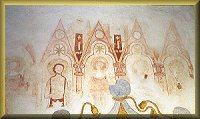THE
CHURCH AT NÖTTJA |
Abbreviated extract from "Nöttjaboken" (the Book of Nöttja)
The church at Nöttja is one of the oldest in the diocese of Växjö. It is situated on a hill at the banks of the river Bolmån, at the end of a long fall with strong currents. In ancient times, this was the place of a water supply and probably also a ford over the river. The church is small and has metre thich walls made of whitewashed natural stones. The foundation is made of big slabs of stone.
The church dates from the late 12th or early 13th century. It was no doubt built to give shelter to children and old age people during the cruel wars that were fought between different creeds when Christianity was introduced in Sweden. At a renovation in 1951 it was discovered that the floor is made of thich oak boards, which had served before as walls of a stave church. Finds of bones beneath both the floor and the walls bear witness that the ground on which the church stands had served as a burial ground long before the introduction of Christianity.
The foundation
of the earlier stave church was discovered under the
present altar. Coins from the period before Christianity were also
found, some of them very rarecoins named "brakteater". Fragments
of paintings were also discovered, some of them were taken out and restored.
Most of the old paintings were however ruined in the 18th century, when
the old windows were enlarged and a new window taken up in the northern
wall near the altar. At that time, the entrances on the long north and
south walls were closed and a new entrance taken up in the western wall.
The picture of a lion and a man on the northern wall symbolises the fight against evil; the evil was believed to come from the north. The boughs in black and red under the triumphal arc and on the ceiling date from the 17th century, and so does the horseman above the lion. Paintings from the 12th century have also been restored on the northern wall of the sanctuary.
The altar piece, bearing the initials of the present king and queen of the region, Adolf Fredrik and Lovisa Ulrika of Sweden, and the present pulpit both date from 1754 when the paintings on the gallery and the pew doors were also added. The crucifix and the baptismal font in limestone date from the 12th century. The wooden king with the crucifix is also from the middle ages.
The bell tower with its coned cap is beautiful and rare and it is younger than the church. Until recently the bells were activated manually. Their ringing is beautiful, the timbre much better when they are rung by hand then electrically.
The church has been well preserved throughout the centuries. It never underwent the rebuilding, so frequently made of other churches during the 15th century, when so many older riches were destroyed forever. It was saved due to the simple fact that the parish at the time was very small and poor, situated in an area where constant wars between Sweden and Denmark drew on the small reserves of the people. The people of Nöttja long felt ashamed of their old, ill-preserved church. It was not until the renovation in 1951 that they became aware of what a treasure their church was - and kept.









Foto: Tommy Lennartsson
